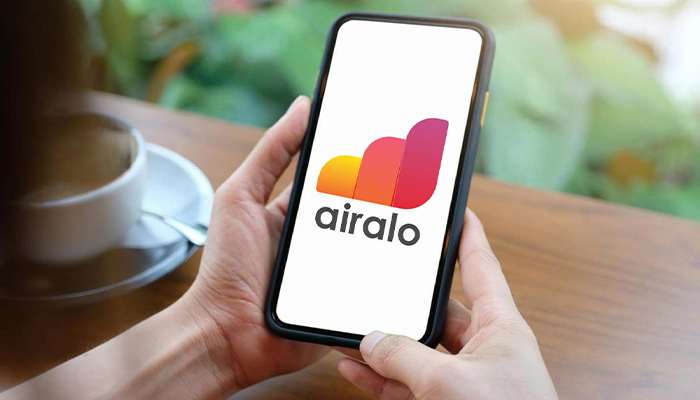How Much Does It Cost to Build an eSIM App Like Airalo and Holafly?

MAR, 20, 2024 15:30 PM
How Much Does It Cost to Build an eSIM App Like Airalo and Holafly?
In the era of digital connectivity, eSIM apps like Airalo and Holafly have revolutionised the way we use mobile networks. This guide explores what eSIM apps are, the benefits of creating one, considerations when choosing a development company, and the associated cost to build an eSIM app like Airalo and Holafly.
What is an eSIM app?
An eSIM app, or embedded SIM application, revolutionises the way users handle their mobile subscriptions by digitising the traditional SIM card. Unlike physical SIM cards that slot into devices, eSIMs are pre-installed, offering a virtualized alternative. The associated app serves as a user-friendly interface, granting individuals control over their mobile connectivity experience.
Through the eSIM app, users can easily manage and switch between mobile carriers without the hassle of physically swapping SIM cards. This digital approach simplifies the process of selecting and changing service providers, providing a more efficient and dynamic experience. Additionally, the app often offers features such as data plans, account management, and detailed usage statistics, empowering users to customise their mobile connectivity in real-time.
In essence, the eSIM app embodies a shift towards a more agile and user-centric mobile experience, enhancing convenience and flexibility in managing mobile subscriptions.
Benefits of Creating an eSIM App:
Global Connectivity:
One of the standout advantages of building an eSIM app like Airalo or Holafly is that it offers users seamless global connectivity. Services like Airalo and Holafly enable individuals to access local data plans in various countries without the hassle of physically swapping SIM cards. This not only ensures constant connectivity during international travel but also eliminates the need for carrying multiple SIM cards.
Flexibility:
The flexibility provided by eSIM apps is a key driver of their popularity. Users can effortlessly switch between carriers and data plans using an intuitive interface. This dynamic control allows individuals to tailor their mobile connectivity to suit their needs, adapting to changes in location, usage patterns, or preferences without any physical constraints.
Cost Efficiency:
The cost-efficient nature of eSIM apps is evident in their ability to help users avoid hefty roaming charges. By choosing local data plans in different countries through the app, individuals can optimise their mobile expenses. This not only enhances financial savings but also ensures that users have access to affordable and tailored connectivity options wherever they go.
Environmental Impact:
Beyond individual benefits, eSIMs contribute to a more sustainable approach to mobile connectivity. By eliminating the need for physical SIM cards and associated manufacturing processes, eSIM apps help reduce electronic waste and minimise the environmental footprint of traditional SIM card production. This eco-friendly aspect aligns with the growing importance of adopting technologies that prioritise environmental sustainability.
Remote Provisioning:
eSIM apps streamline the process of activating and managing mobile subscriptions remotely. This allows users to activate their eSIMs without the need for a physical card, enhancing the convenience of acquiring and using mobile services, especially in situations where obtaining a physical SIM card might be challenging.
Device Integration:
The integration of eSIMs directly into devices simplifies the user experience. There's no need to handle small SIM cards, as the eSIM is embedded during manufacturing. This integration not only reduces the risk of physical damage to SIM cards but also contributes to a sleeker, more compact design for modern devices.
Security Features:
eSIM apps often come with advanced security features, such as remote locking or wiping capabilities. In case of a lost or stolen device, users can take immediate action through the app to protect their personal data, enhancing overall mobile security and providing peace of mind to users.
Future-Proofing:
As technology evolves, eSIM apps position themselves as a future-proof solution. The digital nature of eSIMs enables over-the-air updates, ensuring that devices and apps can adapt to emerging standards and technologies without requiring physical replacements. This future-proofing aspect enhances the longevity and compatibility of mobile devices in an ever-changing technological landscape.
How to Choose the Right Mobile App Development Company:

Experience and expertise:
Prioritise a mobile app development company in Delhi with a solid track record in mobile app development, especially those with specific experience in creating eSIM solutions. An established history in this field indicates a higher likelihood of successful project delivery and expertise in overcoming potential challenges unique to eSIM app development.
Client Reviews:
Delve into client testimonials and reviews to gauge the company's reputation and client satisfaction. Real-world experiences from previous clients provide valuable insights into the company's communication, project management, and overall service quality, helping you make an informed decision.
Portfolio:
Evaluate the company's portfolio to ensure they have a diverse range of successful projects, with a particular focus on user-friendly interfaces. Examining their past work gives you a glimpse into their design and development capabilities, helping you determine if their style aligns with your vision for the eSIM app.
Technology Stack:
Verify that the company stays abreast of the latest technologies for app development. A modern and up-to-date technology stack ensures compatibility with current devices and enhances the scalability of the app for future updates. It also reflects the company's commitment to delivering cutting-edge solutions.
Cost Transparency:
Opt for a UI/UX design company that provides clear and transparent cost estimates. A detailed breakdown of development costs, testing, and post-launch support helps you understand the financial aspects of your project. This transparency is crucial for budgeting purposes and establishes a foundation of trust between you and the development team.
How much does it cost?
Features and Functionality:
The intricate nature of features, encompassing multi-carrier support, diverse user profiles, and seamless payment integration, manifests as a pivotal determinant in influencing the overall development cost of an eSIM app. The greater the complexity and sophistication of these features, the more extensive the resource allocation required, thereby impacting the financial investment in the project.
UI/UX Design:
The paramount significance of a meticulously crafted and inherently intuitive user interface and user experience (UI/UX) design cannot be overstated in the realm of eSIM apps. A judicious investment in the aesthetic and functional aspects of UI/UX design not only contributes substantively to user satisfaction but also exerts a discernible influence on the overarching cost implications of the development endeavour.
Development Time:
The temporal dimension of development, comprising the phases of coding, testing, and deployment, plays a consequential role in shaping the financial outlay associated with creating an eSIM app. The intricacies of incorporating complex features and adhering to stringent timelines may potentially amplify the developmental expenses, necessitating a strategic consideration of resource allocation.
Testing and Quality Assurance:
The indispensable facet of conducting exhaustive testing and implementing stringent quality assurance measures emerges as a non-negotiable component in the developmental trajectory of an eSIM app. Allocating a substantial budget for these rigorous testing procedures becomes imperative to ensure the app's stability, fortify its security infrastructure, and validate its overall functionality, thereby substantiating the fiscal commitment to quality assurance.
Platform Compatibility:
The pivotal decision concerning the compatibility of the eSIM app across diverse platforms, be it iOS, Android, or a harmonious integration of both, looms large as a decisive factor in the cost calculus of development. The pursuit of cross-platform compatibility necessitates heightened resource allocation, as it demands adept navigation of the idiosyncrasies associated with each platform.
Integration with Mobile Networks:
In the pursuit of a globally resonant eSIM app, the intricate choreography required for seamless integration with an array of mobile networks introduces a nuanced layer of complexity that directly correlates with the associated costs. The diversity of carriers and the need for flawless compatibility amplify development efforts and financial investment in order to achieve comprehensive network integration.
Security Measures:
The imperative to fortify an eSIM app with robust security measures while assiduously safeguarding user data and ensuring the impregnability of its operational facets emerges as a cornerstone in the development cost dynamics. The incorporation of advanced security features becomes synonymous with a heightened fiscal commitment, aligning with the uncompromising pursuit of user data protection.
Regulatory Compliance:
The exigency of aligning an eSIM app with the intricate tapestry of international and local regulations governing eSIM technology underscores the importance of regulatory compliance in the developmental narrative. Conforming to these standards necessitates additional developmental efforts and incurs expenses that are intrinsic to meticulous adherence to legal and regulatory frameworks.
Customisation Requirements:
The degree of tailoring required for an eSIM app to align with specific business imperatives or brand identity exerts a discernible impact on the developmental cost matrix. The more intricate and extensive the customisation, the greater the resource allocation required, making it imperative to judiciously assess and factor in these customisation requirements during the budgeting process.
Scalability:
The foresighted incorporation of scalability considerations in the architectural blueprint of the eSIM app emerges as an anticipatory investment poised to accommodate future growth. While this strategic approach may contribute to initial development costs, it positions the app for long-term viability and user satisfaction, thereby offering a prudent cost-saving perspective over time.
Post-launch Support and Maintenance:
The post-launch phase unfurls as an enduring commitment to ongoing support and maintenance, encompassing regular updates, bug fixes, and alignment with new operating system versions. This sustained engagement with the app's evolution post-launch constitutes an integral component in ensuring longevity and user satisfaction, exerting a sustained influence on long-term developmental costs.
Geographical Considerations:
The intricacies embedded within the development location and the regulatory landscape of diverse markets introduce a contextual layer to the cost calculus. Understanding and navigating the specific requirements and conditions in different regions mandates an astute evaluation to accurately budget for the multifaceted geographical considerations inherent in eSIM app development.
Third-party Services:
The strategic utilisation of third-party services, ranging from payment gateways to authentication providers, introduces a nuanced layer of cost considerations. The integration with external services necessitates additional developmental effort, prompting a discerning evaluation of the associated expenses and their impact on the overall financial outlay.
User Onboarding and Education:
In instances where an eSIM app introduces a paradigm shift or novel concept to users, the imperative of investing in comprehensive onboarding features and educational content becomes evident. The meticulous cultivation of user understanding and effective utilisation adds a layer of developmental complexity, entailing a judicious budgetary allocation for these instructional components.
User Support Infrastructure:
The establishment of a robust infrastructure for user support, spanning helpdesk systems and diversified communication channels, crystallises as an indispensable component in the developmental narrative. The allocation of resources for the sustained provision of user support post-launch introduces a recurrent fiscal dimension, underscoring the importance of budgeting for the enduring user support infrastructure inherent in the eSIM app ecosystem.
Conclusion:
Building an eSIM app like Airalo and Holafly offers numerous benefits in terms of global connectivity, flexibility, and cost efficiency. When embarking on this journey, carefully choose a mobile app development company with the right experience and expertise. Consider factors such as the app's features, UI/UX design, and development time to estimate the overall cost accurately. By following these guidelines, you can navigate the process successfully and create a cutting-edge eSIM app that meets the demands of the modern mobile user.
Strategy
Design
Blockchain Solution
Development
Launching
Testing
Maintenance
Contact US!
India

Plot 378-379, Udyog Vihar Phase 4 Rd, near nokia building, Electronic City, Phase IV, Sector 19, Gurugram, Haryana 122015
Copyright © 2025 PerfectionGeeks Technologies | All Rights Reserved | Policy
Contact US!
India 
Plot 378-379, Udyog Vihar Phase 4 Rd, near nokia building, Electronic City, Phase IV, Sector 19, Gurugram, Haryana 122015
Copyright © 2025 PerfectionGeeks Technologies | All Rights Reserved | Policy





